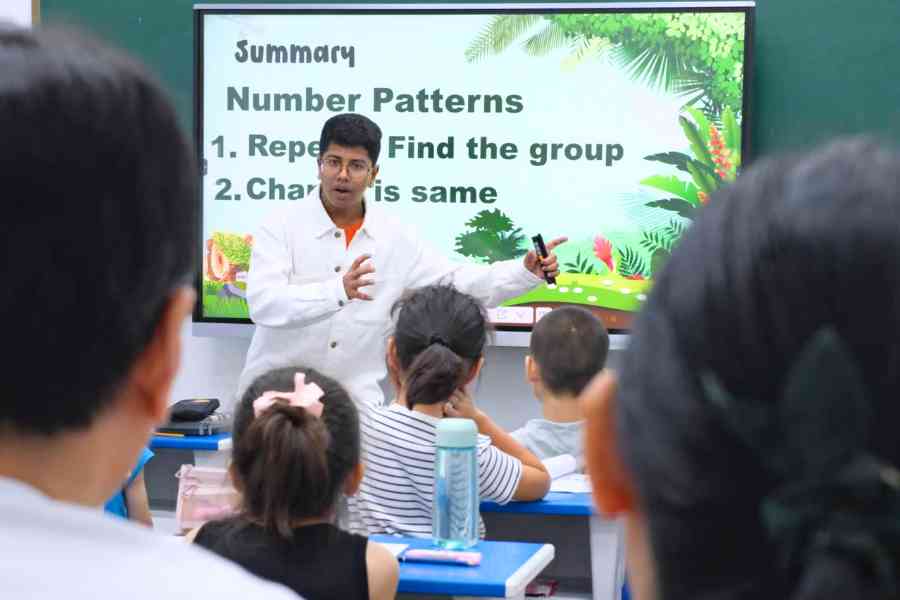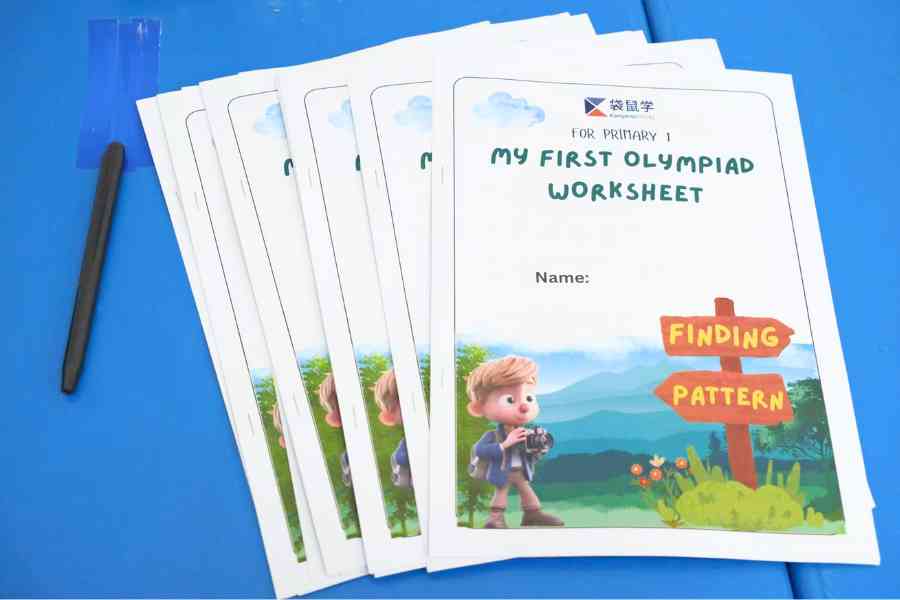An Introduction to Kangaroo Study's Primary 1 Class
This Saturday, Kangaroo Study welcomed curious young learners and their families to a special open class led by none other than Teacher Smith, our Head of Primary 3 and lead teacher for the P1 and P2 Olympiad classes.

For many of the attending Primary 1 students, this was their very first taste of Olympiad-style learning, and what a magical introduction it was!
Class Focus: A Deep Dive into Patterns
In just one hour, Tr. Smith guided students through a thoughtfully structured exploration of number patterns, figure patterns, and even more complex combinations of both. Designed to test number sense and visualization skills, the class struck a perfect balance between challenge and fun.

The lesson even touched on famous sequences like Fibonacci, showing students that math isn’t just about getting the right answer—it’s about noticing beauty, logic, and structure in the world around us.


Teacher Smith brings over four years of teaching experience in both Mathematics and Computer Science. This unique combination allows him to simplify complex ideas and transform them into digestible, step-by-step strategies for young learners.
As Head of our Primary 3 department, and lead teacher for P1 and P2 Olympiad programmes, Smith plays a critical role in helping students excel in GEP preparation, SASMO, SMKC, and other foundational competitions. Beyond technical know-how, he’s known for his ability to foster a vibrant yet structured classroom environment—balancing warmth, discipline, and active participation.
When asked why he chose to join Kangaroo.Study, Smith shared:
“I was truly inspired by the teaching standards and methods here. The highly interactive lessons push students to think critically and find solutions on their own. Even when they make mistakes, we support and guide them patiently—because we believe that real learning happens when students build confidence through discovery. That’s what I love most about teaching here.”
With such a strong foundation in both subject knowledge and classroom delivery, it’s no surprise that many parents choose to start their child’s Olympiad journey early under Teacher Smith’s guidance. But why is it important to begin Olympiad math as early as P1? Let’s take a closer look at the challenges students typically face, and how starting early can make a big difference.
Part 1 What challenges will P1 students face?
When children first enter primary school, many students and parents adopt a relaxed mindset because the difficulty level of P1 and P2 is low, with fewer or no exams, making it hard to notice any gaps in learning. However, by P3, the disparities become increasingly evident. In reality, these gaps are already formed in P1 but only become noticeable by P3. Olympiad math covers a broader and more challenging range of topics compared to the school curriculum. It not only helps P1 students solidify their foundation but also trains them to meet higher standards in habits and methodologies, enabling them to confidently tackle the challenges of higher grades.
Part 2 How can we help students adapt better to the new phase of learning?
P1 students typically exhibit the following learning features:
(1)Short Attention Span (Effective focus lasts about 15-20 minutes)
(2)Concrete Memory (Better retention through physical actions > abstract memorization)
(3)Interest-Driven Learning (Resists repetitive drills without engagement)
Therefore, Kangaroo Study has specifically designed the following components to help children learn mathematics more effectively:
(1) Learning Habits
In the classroom, our teachers place strong emphasis on developing students' learning habits. They establish clear habit expectations and provide consistent follow-up guidance.
We also incorporate structured review practices into our teaching methodology to help students develop effective revision habits.
(2) Concrete Thinking Cultivation
Kangaroo Study designs interactive animated courseware tailored to each lesson's key concepts, incorporating hands-on activities. These dynamic materials transform abstract problems into tangible experiences, enhancing comprehension while boosting classroom engagement and sparking students' enthusiasm for learning
(3) Cultivating Interest
Interest is the key driver of learning, it gives children the motivation to push further and reach new heights. At Kangaroo Study, we prioritize nurturing students’ interest in mathematics.
Hands-on practice is the best way to spark interest.
To transform math from dull and abstract to engaging and fun, we bridge the gap between children and math. Our teachers use real-life examples to explain concepts, showing how math applies to everyday situations. For instance, fractions and percentages are taught through shopping discounts, helping students appreciate how math originates from—and enriches—daily life.
A sense of achievement keeps interest alive.
Sustained interest requires continuous small wins. Through our QPSM teaching method and guided problem-solving, students independently tackle challenges, gaining confidence and pride in their progress. To reinforce this:
Encouragement-based teaching: Teachers provide positive reinforcement.
Reward system: Classroom performance and quiz scores earn points, redeemable for prizes.
Tangible progress: Kids see and feel their "learning results," fostering a love for math.
Kangaroo Study makes math exciting, rewarding, and deeply satisfying! | | | |
| | Study the partitioning of natural numbers. Through this lesson, students will learn methods for systematic and comprehensive thinking. | |
| | Apply clever calculation methods to count 3D shapes and master techniques for counting patterned figures. | |
| | Introduce basic permutation and combination concepts, fostering structured and logical thinking. | |
| Basics of Parity Analysis | Learn about odd and even numbers and their properties in addition/subtraction, applying them to simple real-life problems. | |
| | Develop reasoning skills through real-life scenarios, using methods like sequencing and tables for problem-solving. | |
| Diagramming Word Problems | Analyze common word problems, including comparison and reverse-solving, using simple diagrams. | |
| Clever Addition & Subtraction Tricks | Master two core techniques: "making tens" and "switching signs" for mixed operations. | |
| Addition/Subtraction Number Puzzles | Solve vertical arithmetic puzzles by identifying key positions, strengthening number sense and logic. | |
| | Explore number-filling puzzles to recognize patterns and develop problem-solving strategies. | |
| | Understand certainty vs. uncertainty in events, comparing probabilities with reasoning. | |
| | Read clock times precisely and calculate durations between events. | |
| | Summarize three interval types and apply them to real-world scenarios (foundation for P2 "Tree Planting Problems"). | |
| | Decipher complex problems using structured analysis and arithmetic equations. | |
| | Study front/side/top views of objects to enhance spatial visualization. | |
| | Learn cube unfoldings, identify opposite faces, and boost spatial reasoning. | |
| | Comprehensive review of Lessons 1–15. | |